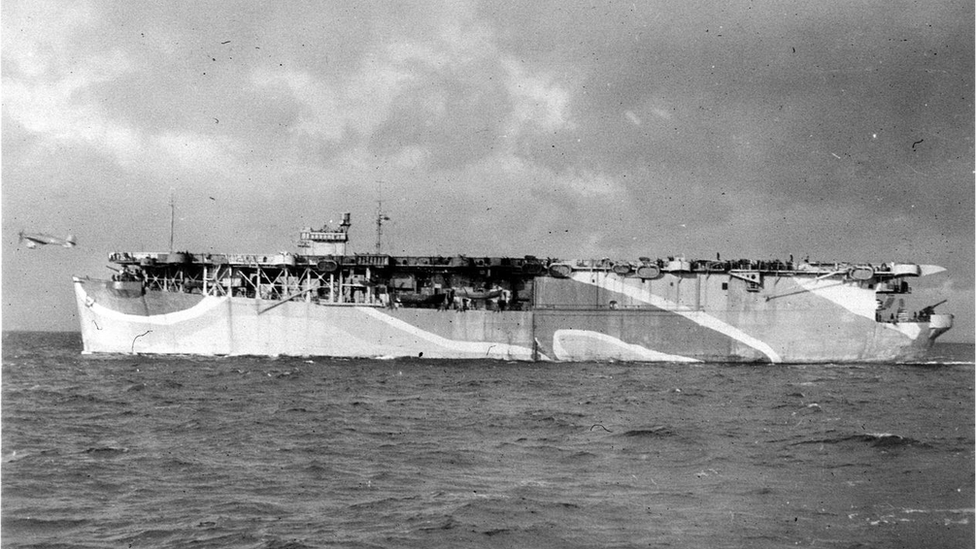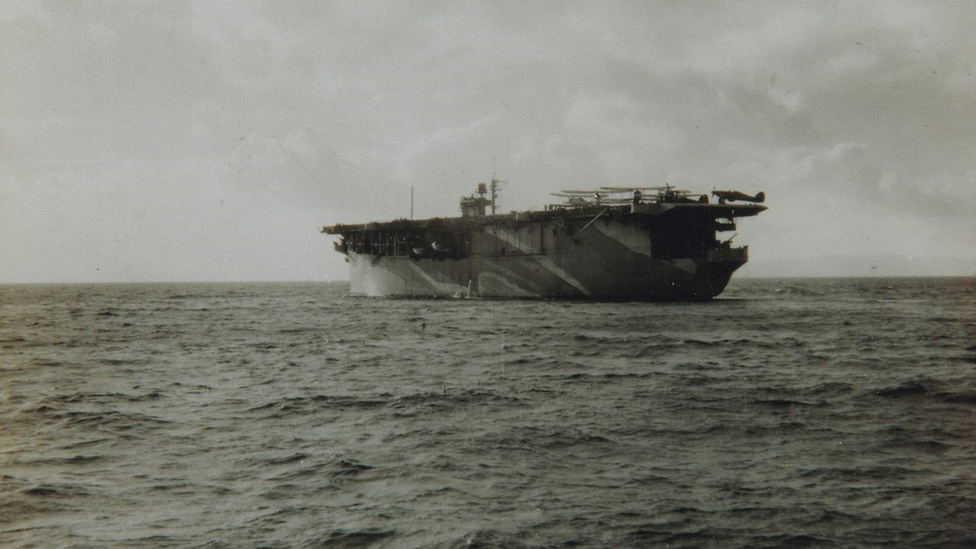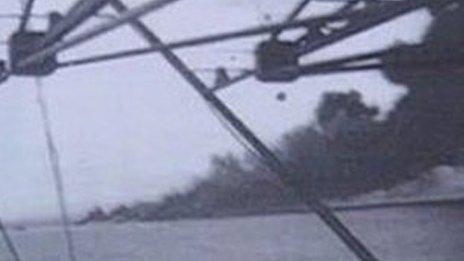The secrecy behind a wartime disaster at sea
- Published

Dame Mary Richardson wants to find where her father and some of his former shipmates might be buried
Dame Mary Richardson is determined to get to the truth of one of the worst wartime disasters in UK waters.
In the season of Remembrance, families will honour loved ones who lost their lives in conflict but Mary and dozens of others have still not managed to find out how their relatives died and where they came to rest.
Her father, George Habgood, was a butcher on board HMS Dasher, an aircraft carrier which blew up in the Firth of Clyde in March 1943 and went down within eight minutes.
The explosion on the carrier, which had been converted from a merchant ship, within sight of the beach near Ardrossan, is thought to have been caused by a petrol leak with vapour subsequently igniting.

HMS Dasher blew up in the Firth of Clyde in March 1943

HMS Dasher was a merchant ship converted into an aircraft carrier
Out of 528 personnel on board, the death toll was 379 but only 23 were given official burials, some in Ardrossan cemetery.
This was despite the disaster happening in calm conditions, a few miles offshore and with rescue ships rapidly in attendance.
It was within living memory and yet little is known to the public of the disaster, even within the local community.
Official documents in the National Archives at Kew in south west London show that bodies were washed ashore for over a week after the disaster but there are no known graves of unidentified seamen.
Mary was just seven when her father died and is now 85.

Mary's father George Habgood was one of 379 men who died in the disaster
She has formed the view that some of the bodies must have been buried in a mass grave somewhere along the Ayrshire coast.
"Somebody must know, I hope somebody knows, and those men can be honoured," she says.
"They seem to have been dishonoured, forgotten, hidden, disgraced and I just want them recognised and it's not just my father I'm worried about.
"It's all of the others who have lain for over 70 years unnoticed."
The National Archives also hold secret government documents from 1943 which reveal the extent to which the authorities went to suppress the news about HMS Dasher's sinking.
Relatives were not told where their loved ones had perished, or which ship they had been on.

Barrie Wright, who is 96, remembers the day Dasher went down
North Ayrshire resident Barrie Wright, who is 96, remembers the day Dasher went down.
He says: "I was walking back from the bus. I got to the highest point on the road. I looked over and I could see the aircraft carrier and the next time I looked back it was just the flames, smoke.
"Everyone seemed to be told no, don't talk about it. Even the survivors were told not to say anything."
Mary argues that the secrecy has gone on far too long.

The explosion on HMS Dasher is thought to have been caused by a petrol leak
She says: "I can understand that during the war things had to be kept secret - and I can understand that Churchill would say we cannot tell the nation that this ship has gone down in our own waters and that 379 have lost their lives.
"I can understand that. But to announce the sinking of the ship in a few lines in the Times, in 1945, and to do nothing for the next 70-odd years, I think is unbelievably cruel."
John and Noreen Steele live near Ardrossan and have tried to find out more about the loss of the carrier.
They have written three books on the subject.
During their research they have interviewed local people and survivors of the disaster.

Noreen Steele says the bodies washed ashore and were dumped in a pit
Noreen, speaking on the beach near her home, says bodies were washed up along the shoreline.
"The mortuary was down there," she says.
"The survivors told us they were taken down to the mortuary to try and recognise them.
"They said there were about 50 bodies laid out for them. They're in a pit somewhere. In a pit. Just dumped.
"There was a high wall but across the road there were tenements. People lived up high and they could see over and the bodies were all laid out in a tennis court. Then they all disappeared."
Dame Mary and the Steeles have been pushing the authorities to excavate possible sites with graves.
A Royal Navy spokesperson said the creation of a mass unmarked grave would clearly run counter to Admiralty policy on the burial of wartime casualties and that all sources relating to the sinking of HMS Dasher are in the public domain.

Former Head of the Royal Navy, Admiral Lord West, believes that there are still unanswered questions
But one former Head of the Royal Navy, Admiral Lord West, believes there are still unanswered questions and the full story has not yet been told.
He says: "That a large ship like that with a very large ship's company should sink in enclosed waters, close to land, that there should be so few bodies that were actually buried together in a cemetery in Scotland - I have real concerns that we haven't seen the full truth about what happened to those bodies."
Dame Mary Richardson says she will not let up in her quest to find where her father and some of his former shipmates might be buried.
She has called on officials to make more effort to help find out what happened. She knows they could have gone down with the ship. But as long as there is a possibility of finding graves onshore she will continue with her search.
Dame Mary says: "These men died for us and we should keep our part of the bargain and recognise and honour them."
Related topics
- Published26 April 2012
